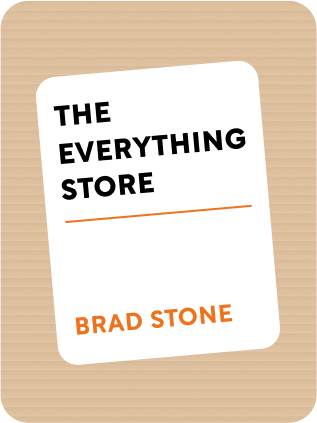

This article is an excerpt from the Shortform book guide to "The Everything Store" by Brad Stone. Shortform has the world's best summaries and analyses of books you should be reading.
Like this article? Sign up for a free trial here .
What events from Amazon’s company history took place between 1999 and 2001? Why did Jeff Bezos decide to become CEO of his own company? What was the “milliravi” incident?
The early 2000s started off rough for Amazon. Many people were skeptical that a middleman company like Amazon could survive, Amazon’s new CEO was a failure, and the milliravi error caused Amazon’s stock to plummet. However, during this time Bezos still somehow managed to keep growing Amazon.
Continue on to learn more about Amazon’s company history.
The Early Days of Amazon
This era of Amazon’s company history begins in the spring of 1999: Amazon’s stock price falls in half from April to May. Investors are questioning Amazon’s widening losses and its ability to ever reach profitability. Typical critical viewpoints are represented by Barron’s “amazon.bomb” article:
- “Despite all the hoopla surrounding Amazon, Bezos has not really revolutionized the book industry at all. In essence, he is a middleman, and he will likely be outflanked by companies that sell their wares directly to consumers. To begin with, publishing houses themselves could sell their books online.” “What’s to stop famous authors from establishing their own Websites to sell their books?”
- “And new technologies promise to cut costs even further by allowing consumers to download books via the Internet. Books can be printed out on traditional computer printers or put into a new notebook-sized computer device that displays books on its screen a page at a time.”
- The article also cites B&N, Borders, CVS, and Wal-mart as threatening juggernauts that would inevitably move online. “Ingram and Barnes & Noble have enough distribution sites to offer overnight delivery at no extra cost to about 80% of the U.S…The best Amazon can offer right now is delivery in three to seven business days, and that’s if it has the book in stock.” “Wal-Mart has resources Amazon can’t even dream of.”
(Shortform note: the story, as we know now in insight, is that
- Amazon was a relentless competitor that continuously improved its retail operations, lowered costs, and expanded its constellation of services into home devices like Alexa and streaming video, driving flywheel effects
- the retail incumbents never executed to Amazon’s level, partially because of disrupting its legacy businesses, per classic Innovator’s Dilemma
- new business lines like Amazon Web Services provide earnings to make retail more cost-competitive
- authors have not reached customers directly as ambitiously idealized in 1999
But these legitimate questions illustrate how difficult it is to foresee the future.)
Amazon’s New CEO
June 1999: with pressures to get the company in order, Bezos agrees to hire a COO, settling on Black and Decker salesman Joe Galli Jr.
- At this time, Bezos is interested in spending more time pursuing other passions like philanthropy, space flight, and raising a family.
- Unfortunately, Galli is largely a failure.
- He tries to order operational rigor and discipline, causing friction with the entrepreneurial employees.
- He is not technical, requiring his emails to be printed to be read and seeing Amazon more as a retail company than a technology company.
- Galli agitated for more authority and wanted to be CEO, while Bezos wants to maintain a firm control over Amazon decisions.
- Galli leaves in July 2000. Bezos realizes he wants to be an active CEO, and Amazon has not had a President or COO since then.
Fall 1999: Amazon is granted a patent for 1-Click purchases.
- Even though Bezos is an advocate for patent reform, he’s determined to exploit the status quo for any possible advantage.
Amazon Expands Again
Fall 1999: Amazon introduces the home and kitchen category. Employees remember kitchen knives flying down the conveyor chutes.
- (Shortform note: former Amazon engineer Steve Yegge wrote that in 1999 Bezos told the company that Amazon was dying. “all we sold were books, music and video, and all of them were being digitized and would die soon. Right then and there he predicted the Kindle and iTunes and Amazon Instant Video, none of which emerged until years later. He said that if we didn’t get into hardlines and other businesses, we’d be dead in a few years. He told us we had to be able to sell and ship anything, a live elephant if need be.”)
September 1999: Amazon hires Jeff Wilke as VP of Operations to replace departing Walmart alum Jimmy Wright.
- To fill the logistics division, Wilke hires scientists and engineers rather than retail-distribution vets. He revamps algorithms to match demand to the correct FC based on customer address, location of merchandise in the FCs, cutoff times for shipping, and backlogs.
- Wilke realizes that Amazon’s distribution is much closer to a manufacturing and assembly problem than it is to retail shipping.
- A few years later, the click-to-ship time is as low as 4 hours, down from 3 days when Wilke joined and the industry standard of 12 hours. Fulfillment gives Amazon a competitive edge over rivals, such as eBay.
- (Nowadays Wilke is CEO of Amazon Worldwide Consumer, responsible for all retail operations.)
- Amusing anecdote: in December 1999, a missing pallet of Pokemon Jigglypuffs caused a bottleneck for shipping orders. They found it after 3 stressful days.
End of 1999: Amazon has $1.64 billion in revenue in the year, up from $610 million in 1998. It now has 20 million registered accounts. Employees number 7,600, up from 1,500 in 1998.
- In contrast to Amazon’s smooth operations, incumbents start online operations online barely survive their first holiday season – Toys R Us is investigated by the FTC for unfulfilled promises made to shoppers.
Amazon in 2000
February 2000: Amazon sells $672 million in convertible bonds to overseas investors at 6.9%. Given the bad environment to come, this provides a needed cushion that might have helped Amazon avoid bankruptcy.
March 2000: The Dotcom bubble hits its peak, wavers until August, and then starts trending down.
- Prior to this, Yahoo is valued more than Disney; Amazon more than Sears.
- Investors wake up from the frenzy and start to demand practical fundamentals from internet companies.
- As Amazon stock price falls, employee options fall underwater, causing resentment (after Bezos’s pushes for relentless work) and lack of faith in the company and leadership.
The “Milliravi” Error
June 2000: Ravi Suria at Lehman Brothers releases a scathing report on Amazon, suggesting “the company will run out of cash within the next four quarters.”
- This contributes to a 20% fall in Amazon’s stock.
- In hindsight, this was incorrect, given Amazon’s near-$1 billion in cash and securities to cover supplier accounts, and its negative-working-capital model.
- However, the risk was that the mere mention of Amazon running out of cash would trigger a self-fulfilling prophecy, scaring away customers and spooking suppliers into requiring immediate payment from Amazon.
- Bezos and Amazon combat this in the press, arguing the analysis is strongly incorrect.
- Internally, they coin the term “milliravi” to indicate a math error of a million dollars or more.
- Regardless, Bezos announces a goal to become profitable by Q4 2001.
July 2000: Harry Potter and the Goblet of Fire is preparing for release. Amazon offers a 40% discount and express delivery so customers will get it on the day it’s released, losing a few dollars per order.
- Despite the short-term losses, it builds goodwill among customers, delivery drivers, and press.
Amazon and Toys R Us
August 2000: Amazon announces a 10-year partnership with Toys R Us, who would become the exclusive toys and baby-products seller on Amazon for the most popular toys. They would also redirect toysrus.com to Amazon.com.
- The idea is for the offline retailer to bring product expertise and relationships with suppliers; in return, Amazon provides the online infrastructure and house inventory in its distribution centers.
- Amazon also benefits by collecting high-margin fees and building its infrastructure to a general platform for many other companies to use.
- Furthering this strategy, in 2001 Amazon signs Borders, Circuit City, Target, Eddie Bauer, and Nordstrom as sellers.
- Despite the profits, Bezos is never fully comfortable with outsourcing the goal of limitless selection to outsiders.
- (Shortform note: In 2005, Toys R Us sues Amazon for breaking its exclusivity agreement and listing other toy retailers. Amazon claims Toys R Us failed to provide a required selection of toys, and that Toys R Us only had exclusivity over the toys it sold. In the long run, partnering with Amazon prevented Toys R Us and other retailers from developing internal capabilities on the Internet.)
September 2000: Blue Origin is registered but stays unknown until 2003, when it begins acquiring land in Texas and reporters investigate.
- Bezos says “it’s premature for Blue to comment on anything because we haven’t done anything worthy of comment.”
The Amazon Marketplace Is Born
November 2000: Amazon launches Marketplace, allowing other sellers to sell on Amazon.
- This comes from reasoning that traffic to Amazon was centered around its definitive, reliable product catalog. If you go to eBay and search for a book, you’ll find dozens of copies of varying condition and price. If you go to Amazon, there’s a single page with a definitive description and price.
- Amazon decides it needs to list sellers’ wares alongside its own products on these definitive pages, not silo the third party sellers in another site like Auctions did.
- This faces backlash from publishers and authors, who argue Amazon is favoring used book sales.
- Internally in Amazon, category managers also dissent, worried about third parties listing cheap wares that would cut into Amazon’s numbers, and about third parties with poor service leading to poor reviews.
- Ultimately, Bezos cares only about broader customer selection, and Marketplace pushes through.
- Later, Marketplace will serve as a valuable way for Amazon to learn how third parties are beating Amazon on pricing, and as a way to list goods that manufacturers refuse to supply Amazon (like Wusthof knives).
December 2000: Bezos meets with Walmart CEO Lee Scott, who espouses the philosophy of using pricing as advertising.
- “We spend only forty basis points on marketing. Most of that goes to newspapers to inform people about what is in our stores. The rest of our marketing dollars we pour into reducing prices. Our marketing strategy is our pricing strategy, which is everyday low pricing.”
End of 2000: Amazon has $2.76 billion in revenue, up from $1.64 billion in 1999.
March 2001: After another Ravi Suria report, Bezos sells shares worth $12 million. The SEC investigates Bezos for insider trading.
- “I don’t care who you are or how much chutzpah you have – it’s not fun picking up the Times and seeing your picture above the fold accused of insider trading. This is one of the things that made Jeff the person he is. That scar does not heal easily.” – CFO Warren Jenson
- Around this time, Amazon cuts 1,300 people (15% of the workforce), some who had been hired just months earlier, and reprices the stock options of employees (exchanging 3 shares at old price for 1 at new price).
- Growth in books appears to be slowing after annual double-digit increases. Amazon workers are afraid Walmart.com would start selling books at a loss to stifle Amazon’s growth. Initially Bezos signs off on increasing prices, until they arrive at a revelation on their business’s key strategy.

———End of Preview———
Like what you just read? Read the rest of the world's best book summary and analysis of Brad Stone's "The Everything Store" at Shortform .
Here's what you'll find in our full The Everything Store summary :
- How Amazon went from an online bookstore to the largest internet retailer in the world
- What Jeff Bezos did to compete with companies like eBay, Zappos, and Diapers.com
- What it was like to work for Jeff Bezos






